#Crop Management Software
Explore tagged Tumblr posts
Text
Crop Production Software — Navfarm

Agriculture has always been the backbone of India’s economy. With millions of farmers across the country cultivating crops to feed the nation, managing a farm efficiently has become more challenging than ever. Traditional farming methods, while effective in many ways, are often hindered by inefficiencies, weather unpredictability, and manual errors. Enter Crop Management Software — a game-changing tool that is transforming agriculture into a more organized, data-driven industry.
In this article, we’ll explore how Crop Management Software and Agriculture Farm Management solutions like NavFarm are helping farmers across India boost productivity, reduce costs, and make more informed decisions. From seed selection to harvesting, farm management software is reshaping how farming operations are run, ensuring that farmers can manage their resources with precision and insight.
What is Crop Management Software?
At its core, Crop Management Software is designed to assist farmers in managing their crops and farming operations more efficiently. This software integrates various aspects of farming — from planning and planting to monitoring, managing, and harvesting crops. It allows farmers to track key metrics, such as crop growth, pest activity, irrigation needs, and soil health, ensuring they can make data-backed decisions to maximize yield and reduce waste.
For farmers in India, where agriculture is often dependent on unpredictable weather and limited access to advanced technology, Crop Management Software acts as a crucial tool to navigate these challenges. It helps farmers monitor their crops in real-time and make the right decisions at every stage of the farming cycle.
How Does Crop Management Software Help Indian Farmers?
India is a diverse country, with different climates, soil types, and farming practices across regions. This makes Agriculture Farm Management a complex task that requires careful planning and consistent monitoring. Crop management software addresses these challenges by offering a suite of features that make farming operations easier to manage.
Here are some of the key ways Crop Management Software is helping Indian farmers:
Precision Agriculture: By using sensors, satellite data, and mobile applications, crop management software enables farmers to practice precision agriculture. This means farmers can apply fertilizers, water, and pesticides more precisely, reducing waste and improving yield.
Weather Forecasting and Alerts: Weather plays a significant role in Indian agriculture, and crop management software often integrates real-time weather forecasts. This feature helps farmers stay updated on potential weather changes, such as rain, drought, or extreme temperatures, which can impact crop health.
Farm Data Analytics: Data is a valuable asset in modern agriculture. Software like NavFarm collects and analyzes farm data, enabling farmers to track key performance indicators (KPIs) like soil moisture, nutrient levels, crop health, and pest activity. With this data, farmers can make better decisions, such as when to irrigate, fertilize, or apply pest control measures.
Resource Optimization: Efficient use of resources such as water, labor, and inputs like fertilizers and pesticides is critical for profitability. Crop Management Software helps farmers monitor their resource usage, reducing costs and minimizing waste. This is especially important in India, where many farmers face resource constraints.
Record Keeping and Documentation: Managing farm records manually can be tedious and prone to errors. NavFarm, for example, simplifies record keeping by storing important documents like crop details, financial transactions, and input usage in one easy-to-access platform. This helps farmers maintain proper documentation for government subsidies, loans, and insurance claims.
The Role of NavFarm in Agriculture Farm Management
Among the numerous Crop Management Software options available, NavFarm stands out as a comprehensive solution for Indian farmers. As a leader in Agriculture Farm Management, NavFarm is designed to meet the unique challenges faced by farmers in India, offering a combination of innovative features and user-friendly interfaces.
Key Features of NavFarm
Comprehensive Farm Management: NavFarm allows farmers to manage their entire farm operation through a single platform. From sowing to harvesting, the software tracks every stage of crop development, providing real-time data and insights.
Customizable Crop Planning: With NavFarm, farmers can create customized crop calendars based on their region’s specific climate conditions and soil types. This ensures that farmers plant and harvest at the optimal time, maximizing productivity.
Mobile App Integration: In India, smartphone usage among farmers is on the rise, making mobile applications an effective tool for managing farms. NavFarm provides a mobile app that syncs with its desktop platform, giving farmers access to real-time updates, alerts, and analytics right from their smartphones.
Soil Health Monitoring: Soil health is crucial for a successful harvest. NavFarm integrates soil health monitoring tools, allowing farmers to track key soil parameters such as pH, moisture content, and nutrient levels. This ensures the soil is in optimal condition for crop growth.
Financial and Inventory Management: Managing finances and inventory can be daunting, especially for small-scale farmers. NavFarm helps farmers track expenses, monitor cash flow, and keep an eye on inventory, such as seeds, fertilizers, and pesticides. This streamlined approach reduces financial risk and helps farmers make more informed budgeting decisions.
Pest and Disease Management: NavFarm provides tools to detect early signs of pest infestations or diseases, helping farmers take timely action to protect their crops. By integrating pest management recommendations with weather data, the software helps farmers minimize the use of pesticides, promoting sustainable farming practices.
Support for Smallholder Farmers: One of the major advantages of NavFarm is its affordability and scalability. Designed to cater to farmers of all sizes, including smallholder farmers, the platform offers features that help even the most resource-constrained farmers enhance their productivity.
How NavFarm Supports Sustainable Farming in India
Sustainability is at the heart of modern agriculture. With growing concerns over climate change, soil degradation, and water scarcity, farmers are increasingly looking for ways to make their practices more sustainable. Crop Management Software like NavFarm plays a critical role in promoting sustainable farming by offering tools that help reduce resource wastage, lower the carbon footprint, and increase soil health.
Water Management: Water scarcity is a growing concern in many parts of India. NavFarm’s irrigation management tools enable farmers to monitor water usage and avoid over-irrigation, ensuring that crops receive just the right amount of water for optimal growth.
Organic Farming Support: With the rise of organic farming, NavFarm helps farmers manage organic practices by tracking the usage of natural fertilizers, promoting crop rotation, and managing pest control without harmful chemicals.
Reduced Chemical Usage: By accurately predicting the need for pesticides and fertilizers, NavFarm minimizes the overuse of harmful chemicals. This not only helps reduce the environmental impact but also ensures that farmers produce healthier, chemical-free crops.
Conservation of Biodiversity: The software encourages practices such as mixed cropping and agroforestry, which are beneficial for preserving biodiversity and ensuring long-term farm sustainability.
The Future of Crop Management Software in India
As India moves towards digitizing its agricultural sector, the role of Crop Management Software will only continue to grow. With the government’s focus on “Digital India” and agricultural reforms, more farmers are likely to adopt technology-driven solutions like NavFarm to improve efficiency, boost productivity, and contribute to the nation’s food security.
Farmers will benefit from increased access to real-time data, market trends, and improved financial management. The integration of artificial intelligence (AI), machine learning (ML), and Internet of Things (IoT) technologies with crop management software is expected to further enhance farm productivity, making it easier to predict yields, identify disease outbreaks, and optimize the use of resources.
Conclusion
In the face of growing challenges in agriculture, from climate change to resource scarcity, Crop Management Software like NavFarm offers a powerful solution to help farmers navigate these issues. By providing tools for precise monitoring, data-driven decision-making, and resource optimization, NavFarm is leading the way in Agriculture Farm Management in India.
The future of farming is digital, and with platforms like NavFarm, Indian farmers are better equipped than ever to boost productivity, enhance sustainability, and secure their livelihoods for the years to come.
For farmers looking to take their operations to the next level, adopting Crop Management Software is no longer just a choice — it’s a necessity.
0 notes
Text
Revolutionizing Agriculture with Precision Crop Management Software
Explore how Crop Management Software is transforming precision farming by enabling data-driven decision-making, real-time field monitoring, and resource optimization. With innovative tools from FarmerP, farmers can enhance crop health, boost yields, and achieve sustainability goals. Stay ahead in modern agriculture with cutting-edge solutions tailored to your needs.
0 notes
Text
Best in 2024- Crop Management Software
Discover the leading crop management software for crop planning and intelligent decision-making for agri-businesses around the globe.Streamline operations, enhance crop management, and optimize productivity with our efficient agriculture software. Experience the power of Microsoft Dynamics 365 for agriculture farming. Try Navfarm today.

0 notes
Text

Crop Management Software Revolution
https://www.navfarm.com/agriculture
0 notes
Text
#farm management software#farm management#farming#agriculture#agtech#agriculture technology#agritech#science#technology#crop
1 note
·
View note
Text
Elevate Your Farming Efforts: Discover Agriculture Management Software by Kheti Buddy
Dive into the future of farming with Kheti Buddy's advanced agriculture management software. From seamless crop management to precise inventory tracking, our intuitive tools empower farmers to optimize every aspect of their operations. Monitor soil health, analyze weather patterns, and enhance resource allocation for sustainable agriculture solutions. Embrace cutting-edge technology to streamline workflows, boost productivity, and make informed decisions that drive profitability. Join a community of forward-thinking farmers revolutionizing agriculture with Kheti Buddy's innovative software.
#agtech#agriculture technology#crop protection#farming#agritech#agriculture#pest control#agriculture management software
0 notes
Text

Download Link
Pass: drop357
Adobe Lightroom 2024 Full Crack. Simple and advanced, that’s how you can describe this photo editing software from Adobe. By using this application you can easily produce interesting and colorful photos.
This version comes as a development of version 2023. In this version, Adobe Sensei did a lot of development to make this application more complete.
You will Experience more stable and powerful performance as well as a simple and intuitive interface. In addition, the features are also much more sophisticated.
To make your photos look more attractive, Adobe added a new Lens Blur Tool to adjust the blur in the image. In addition, integration support with other Adobe applications such as Photoshop is felt to be getting better.
If you are interested in this Lightroom 2024 crack, make sure your PC is using Windows 10 or 11. So get Adobe Lightroom 2024 full version free download on the Google Drive panel below.
#Photo editing#Adobe Lightroom Crack#Image management#Batch editing#Crack#Color correction#Adobe design#White balance#Noise reduction#Lens correction#Crop tool#Adobe#Install software#Export settings#Adobe 2024#HDR merging#Panorama stitching#Lightroom Crack#Portrait enhancement#Install
1 note
·
View note
Text
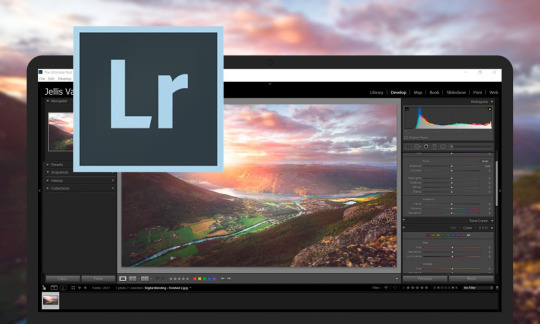
Download link
Pass: drop357
Adobe Lightroom 2024 Full Crack. Simple and advanced, that’s how you can describe this photo editing software from Adobe. By using this application you can easily produce interesting and colorful photos.
This version comes as a development of version 2023. In this version, Adobe Sensei did a lot of development to make this application more complete.
You will Experience more stable and powerful performance as well as a simple and intuitive interface. In addition, the features are also much more sophisticated.
To make your photos look more attractive, Adobe added a new Lens Blur Tool to adjust the blur in the image. In addition, integration support with other Adobe applications such as Photoshop is felt to be getting better.
If you are interested in this Lightroom 2024 crack, make sure your PC is using Windows 10 or 11. So get Adobe Lightroom 2024 full version free download on the Google Drive panel below.
#Photo editing#Adobe Lightroom Crack#Image management#Batch editing#Crack#Color correction#Adobe design#White balance#Noise reduction#Lens correction#Crop tool#Adobe#Install software#Export settings#Adobe 2024#HDR merging#Panorama stitching#Lightroom Crack#Portrait enhancement#Install
0 notes
Text
Evolving Agricultural Practices: Implementing Farm Management Systems for Sustainable Farming
The evolution of agriculture in India is moving towards more sustainable practices. Combining traditional wisdom and modern technology is shaping a new era of farming, which is both environmentally friendly and economically viable. However, the vast majority of Indian farmers still rely on outdated and inefficient farming methods, which leads to lower yields and environmental degradation.
The Concept of Farm Management System:
FMS are modern solutions that aim to streamline the entire farming process. These systems leverage AI, big data analytics, and IoT to monitor soil health, automate irrigation, optimise fertiliser usage, and predict crop yields.
They can transform every phase of farming, from seed selection to harvest, into a data-driven process. This innovative approach to agriculture increases productivity, reduces environmental impact, and improves profitability, thereby making farming more sustainable in the long run.
The Significance of Farm Crop Management Systems:
Crop Management Systems, a subset of FMS, are designed to optimise crop production. They provide real-time insights into crop health, pest infestation, and nutrient deficiency, allowing farmers to make informed decisions.
These systems can predict weather conditions and suggest the most suitable crops for cultivation based on soil type and region, thus reducing the risk of crop failure. By increasing yield and minimising resource wastage, these systems significantly contribute to the sustainability of Indian agriculture.
Real-world Applications of FMS in India:
These are not just theoretical concepts but are being applied successfully across India. For instance, in one of the Indian states, a tech-based initiative has led to a significant reduction in the overuse of water for paddy cultivation. Similarly, in one of the southern regions, zero-budget natural farming practices, backed by data-driven insights, have been implemented on a large scale, promoting biodiversity and enhancing soil health. These examples underscore how integrating FMS can revolutionise farming practices and improve sustainability.
The Future of Farming: How FMS are Shaping Sustainable Agriculture in India
The potential of FMS in driving sustainable farming in India is vast. As the technology becomes more affordable and accessible, more farmers are expected to adopt these systems. Consequently, we foresee a future where data-driven farming becomes the norm, leading to increased productivity, reduced environmental impact, and improved farmer livelihoods. Thus, FMS will play a pivotal role in shaping the future of sustainable agriculture in India.
Conclusion: Embracing Technology for a Sustainable Future in Indian Farming
Embracing the Farm Management System is a crucial step toward a sustainable future for Indian agriculture. These innovative solutions are transforming how we farm, making it more efficient, profitable, and environmentally responsible. It's time to leverage technology and reimagine agriculture for a more sustainable and prosperous future.
0 notes
Text
Laios Touden and the Responsibility of Power
First off, let me gush just a bit about how fucking STRONK this man is. Olympic weightlifters are dying of sheer envy and lust over this man. He is a FUCKING POWERHOUSE.

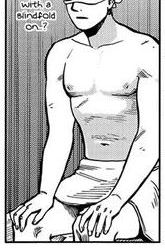
My favorite panels ever, and judging by the cropping of the second photo, Tumblr agrees.
AHEM, where was I?
Ah yes. He's not just strong and incredibly hot, my man is literally an invasive species in this dungeon. He knows every single weak spot of every monster Thistle tried to throw at him and when he finds it he just fucking RAMS HIMSELF AT THEM AND TAKES THEM DOWN.
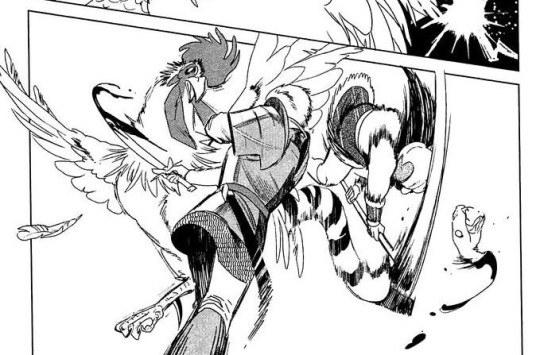
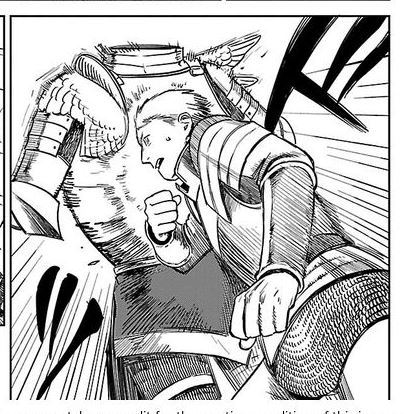
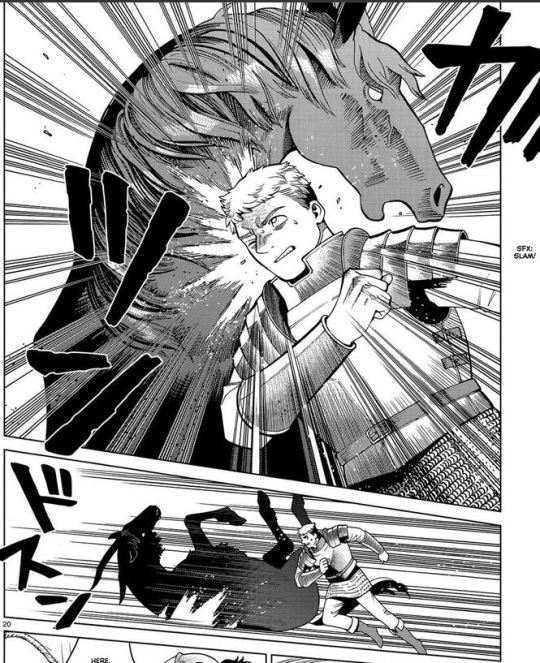
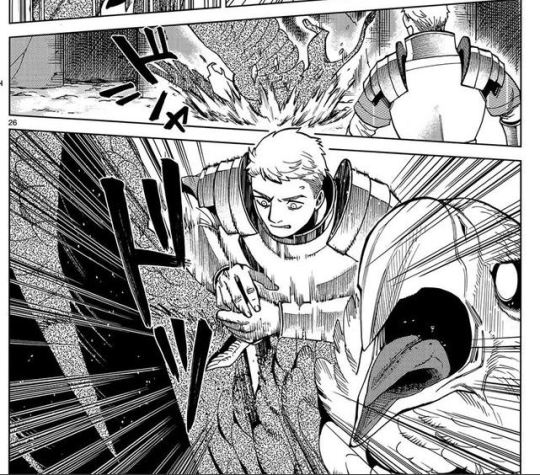
And when he's a dwarf HE LITERALLY BENDS STEEL.
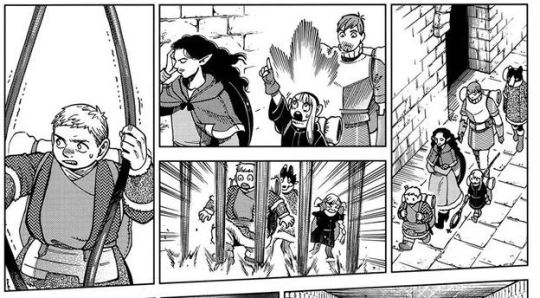
"Beat Namari at arm wrestling"? My boy, she wouldn't let you anywhere near because you'd FUCKING BREAK HER HER HAND ALONG WITH THE TABLE. (It's such a fucking shame we didn't see Senshi at least raising an (perfectly plucked except it just grows that way naturally) eyebrow in the background when he sees this. Alas, he was too distracted by his hair.)
But I mentioned responsibility, didn't I? Strength is power in the dungeon, and we all knows what comes with great power. And Laios is, in fact, very responsible with that power!
(Futther examples under the cut, wee bit spoilers for anime watchers)
This scene lives rent-free in my head forever, because of two things: Thistle suddenly realizing just what the hell he's up against,

And Laios breaking Thistle's arm.
Now, I think Laios didn't mean to actually break his arm here, he's just half-blind and dizzy and knows he has to restrain Thistle or it will all go to shit. So that's what he does. The move you see above is a restraining hold. The point is that the person pinned down can't struggle much because the position of the arm presses the suprascapular nerve, so it hurts a lot, but unless they're held that way for too long they'll be fine.
But Thistle is TINY and elves are generally fine-boned. I think Laios really did just underestimate his strength.
And the moment the dragons aren't an IMMEDIATE THREAT anymore?
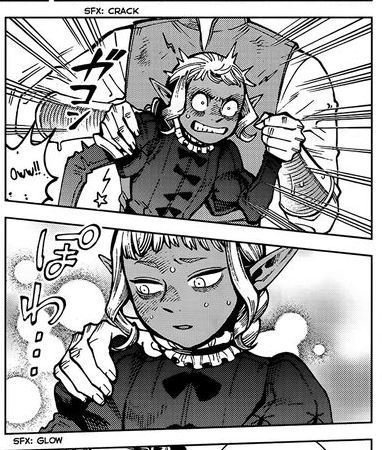
Laios heals him. Thistle's a better mage than him by miles, he could have done it himself. But no. Laios does it. He was too rough, too careless with his strength, and he immediately backtracked, fixed what he broke, and continued with more mindfullness.
And these are just the examples that stuck in my mind the most. And it happens often enough that the team isn't even fucking surprised! Laios' strength would 100% scare people who only saw him in a barfight and didn't know anything else about him. Hell, the other adventurers they meet fucking quiver before this guy who just took down a monster they had nightmares about in one blow, up until he opens his mouth and they relax. You put more malevolent software in that sort of hardware and he'd be the next Shadow Governor.
But Laios is Laios. He's a gentle soul at heart (a Great Pyrenese, specifically, the gentlest souls ever unless you're out for their flock) and he is VERY CAREFUL with his strength, ESPECIALLY around his team. Chilchuck, who is literally half his size and underfed to boot, can smack Laios as much as he wants with ZERO fear because Laios is aware he can hurt Chilchuck by literally tripping over him, so he just stays still and lets Chilchuck smack at him. I'd be surprised if he ever managed to leave a bruise. Chilchuck has to aim at Laios' weak spot (back of the knee here) just to get Laios to notice him!


But because I have some experience with marital arts and close combat, I think the fight with Shuro exemplifies my point so fucking well! Laios is HURT here, he's living every autistic person's worst nightmare.
And he HOLDS BACK. His restraint is fucking IMMACULATE.
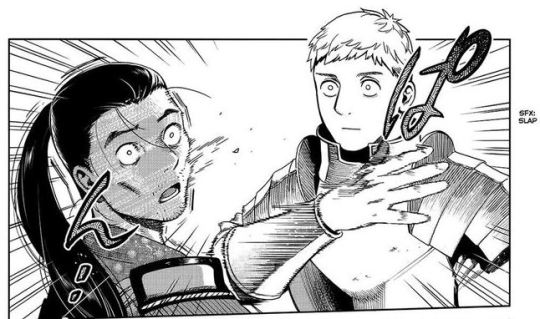
Shuro is fucking lucky Laios still liked him when he started talking shit, because he would have broken his spine otherwise. Laios doesn't even take the fight seriously! He starts with a fucking SLAP.
Shuro retaliates with an actual punch (that does nothing but piss him off)
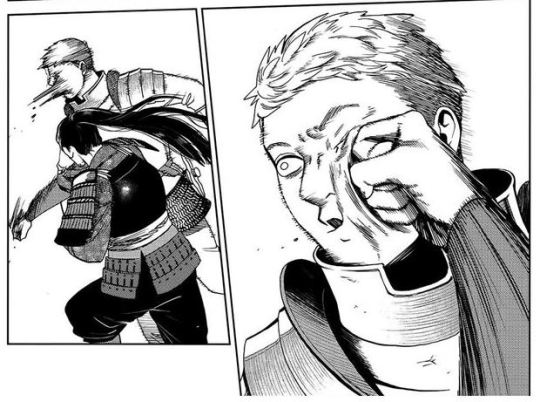
Laios wobbles. Shuro HITS THE DIRT.
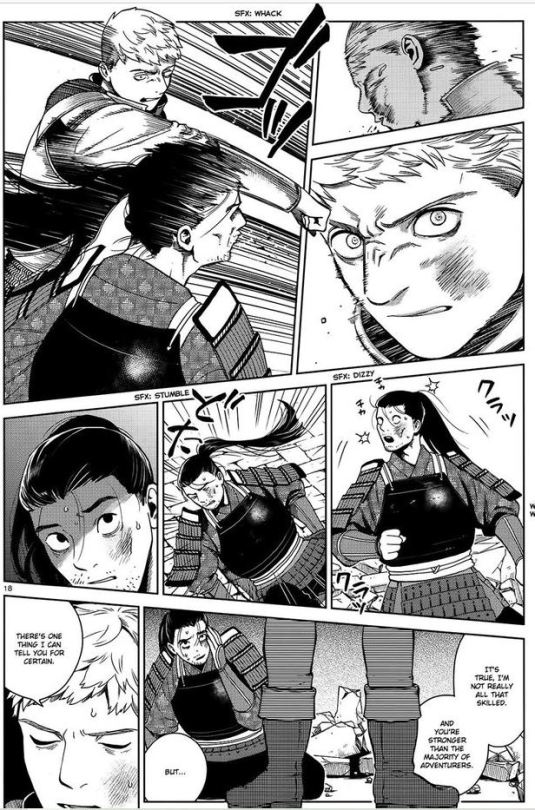
And this is the part where he realizes just how outside his weight category he is. Shuro definitely has technique on his side, but that means jackshit when you need ten blows to to even bruise your opponent, but one hit from them will leave you drinking through a straw for a week. For a second there, Shuro thought he was in ACTUAL DANGER.
But instead of finishing the job, Laios tries to talk him down, which just sets him off again. Man was at his fucking LIMIT, and it snapped. Self-preservation who?
And the best part is? Shuro is throwing all his strength behind his punches and Laios just takes them, but Laios? He mostly pushed Shuro around!
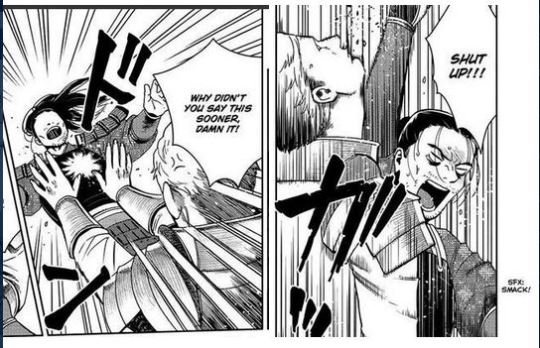
They're mostly grappling here, precisely because Laios is very conscious his friend is pretty fragile right now.
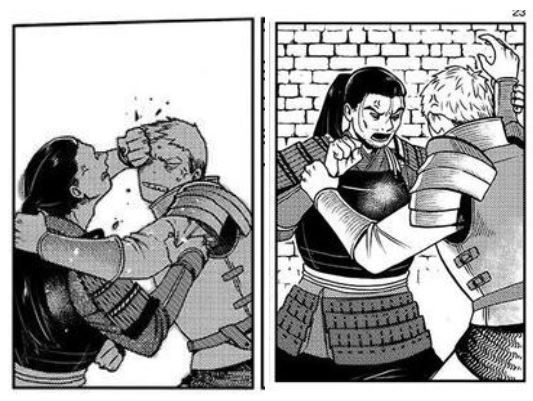
And when he does have enough?
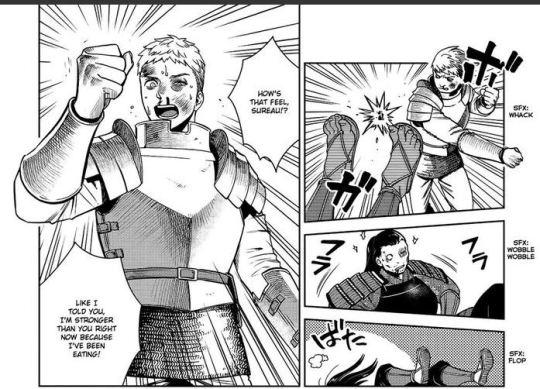
Shuro is flat on the ground again, and Laios has a black eye and a bloody nose. He sits down and five minutes later he's ready to go! Like yes, Shuro was at a low point here, but he's been mowing through monsters at only a bit slower pace than Laios' party. He's no weakling regardless. And Laios had to HOLD BACK SO HE WOULDN'T HURT HIM. And it's so obvious that Maizuru takes one look at the two of them and leaves them to their toussling.

When I saw her reaction I had to scroll back and take another look, because I was sure she would intervene! But she doesn't! She is aware of Laios' strength, she has to be, and she doesn't lift a finger to help her precious charge. She knows the big dog he's wrestling with knows to watch his strength.
And that's my whole point: my boi is STRONK AF! And he is very aware of his strength, and how he could hurt the people around him is he wasn't careful, so he is ALWAYS CAREFUL. He has deeply internalized the fact that to have strength is to be careful with it, to use it in service of people rather than to hurt them (possibly from his dad). He is going to SUCH a good king! He's not going to like the job but by GOD he will do it really well.
And I will give my right arm to see a fic about the first corrupt lord/governor/courtier who attempts to misuse their authority for their own gain. Kabru's gonna have to talk Laios out of an execution.
3K notes
·
View notes
Text
Key Milestones in the Development of Crop Management Software
Crop management software operates through a data-driven process that optimizes farming practices. It begins with data acquisition, where sensors and devices collect information on factors like soil conditions, weather, and crop health. This data is then processed and analyzed using advanced algorithms, identifying trends and potential issues.
0 notes
Note
tell me about your defense contract pleage
Oh boy!
To be fair, it's nothing grandiose, like, it wasn't about "a new missile blueprint" or whatever, but, just thinking about what it could have become? yeesh.
So, let's go.
For context, this is taking place in the early 2010s, where I was working as a dev and manager for a company that mostly did space stuff, but they had some defence and security contracts too.
One day we got a new contract though, which was... a weird one. It was state-auctioned, meaning that this was basically a homeland contract, but the main sponsor was Philip Morris. Yeah. The American cigarette company.
Why? Because the contract was essentially a crackdown on "illegal cigarette sales", but it was sold as a more general "war on drugs" contract.
For those unaware (because chances are, like me, you are a non-smoker), cigarette contraband is very much a thing. At the time, ~15% of cigarettes were sold illegally here (read: they were smuggled in and sold on the street).
And Phillip Morris wanted to stop that. After all, they're only a small company worth uhhh... oh JFC. Just a paltry 150 billion dollars. They need those extra dollars, you understand?
Anyway. So they sponsored a contract to the state, promising that "the technology used for this can be used to stop drug deals too". Also that "the state would benefit from the cigarettes part as well because smaller black market means more official sales means a higher tax revenue" (that has actually been proven true during the 2020 quarantine).
Anyway, here was the plan:
Phase 1 was to train a neural network and plug it in directly to the city's video-surveillance system, in order to detect illegal transactions as soon as they occur. Big brother who?
Phase 2 was to then track the people involved in said transaction throughout the city, based on their appearance and gait. You ever seen the Plainsight sheep counting video? Imagine something like this but with people. That data would then be relayed to police officers in the area.
So yeah, an automated CCTV-based tracking system. Because that's not setting a scary precedent.
So what do you do when you're in that position? Let me tell you. If you're thrust unknowingly, or against your will, into a project like this,
Note. The following is not a legal advice. In fact it's not even good advice. Do not attempt any of this unless you know you can't get caught, or that even if you are caught, the consequences are acceptable. Above all else, always have a backup plan if and when it backfires. Also don't do anything that can get you sued. Be reasonable.
Let me introduce you to the world of Corporate Sabotage! It's a funny form of striking, very effective in office environments.
Here's what I did:
First of all was the training data. We had extensive footage, but it needed to be marked manually for the training. Basically, just cropping the clips around the "transaction" and drawing some boxes on top of the "criminals". I was in charge of several batches of those. It helped that I was fast at it since I had video editing experience already. Well, let's just say that a good deal of those markings were... not very accurate.
Also, did you know that some video encodings are very slow to process by OpenCV, to the point of sometimes crashing? I'm sure the software is better at it nowadays though. So I did that to another portion of the data.
Unfortunately the training model itself was handled by a different company, so I couldn't do more about this.
Or could I?
I was the main person communicating with them, after all.
Enter: Miscommunication Master
In short (because this is already way too long), I became the most rigid person in the project. Like insisting on sharing the training data only on our own secure shared drive, which they didn't have access to yet. Or tracking down every single bug in the program and making weekly reports on those, which bogged down progress. Or asking for things to be done but without pointing at anyone in particular, so that no one actually did the thing. You know, classic manager incompetence. Except I couldn't be faulted, because after all, I was just "really serious about the security aspect of this project. And you don't want the state to learn that we've mishandled the data security of the project, do you, Jeff?"
A thousand little jabs like this, to slow down and delay the project.
At the end of it, after a full year on this project, we had.... a neural network full of false positives and a semi-working visualizer.
They said the project needed to be wrapped up in the next three months.
I said "damn, good luck with that! By the way my contract is up next month and I'm not renewing."
Last I heard, that city still doesn't have anything installed on their CCTV.
tl;dr: I used corporate sabotage to prevent automated surveillance to be implemented in a city--
hey hold on
wait
what
HEY ACTUALLY I DID SOME EXTRA RESEARCH TO SEE IF PHILLIP MORRIS TRIED THIS SHIT WITH ANOTHER COMPANY SINCE THEN AND WHAT THE FUCK

HUH??????
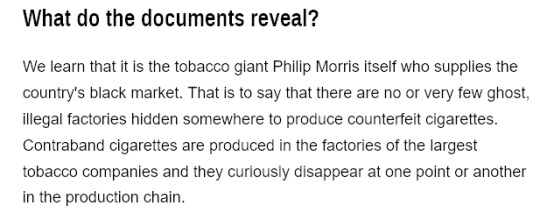
well what the fuck was all that even about then if they already own most of the black market???
#i'm sorry this got sidetracked in the end#i'm speechless#anyway yeah!#sometimes activism is sitting in an office and wasting everyone's time in a very polite manner#i learned that one from the CIA actually
160 notes
·
View notes
Text
My stream of conscious having just finished the 4th episode of The Heart Killers:
I’m so confused… I thought they were hit men. But they also plant bugs and tap into software like spies. And they’re also just plain thieves who break into safes to steal jewels? And they have such an extensive wardrobe. Did they also rent a fire truck or hop out Fadel’s jeep dressed like firemen? Did they start a fire? Is there a cat stuck in a tree? Where did Bison get a fresh janitor’s outfit w/ no wrinkles & a PE outfit in their sizes in less than an hour? Speaking of which, where in the world did Style get a burger costume? I can only imagine it’s handmade. What other crafts does Style like to do? When will Style ever help his dad at the shop? Does Style order crop tops or know how to hem and crops any shirt he likes himself? Is he bisexual? Everyone has chemistry with everyone. When will they have a foursome? Is that incest? And why do Fadel and Bison have a burger restaurant as a cover up in the first place? A cover up for what exactly? It’s not a money laundering front. Is it illegal to arrest small business owners in Thailand? Is it truly just Fadel’s passion project? Why does he love burgers? Where did he learn to cook and manage a business? Did he take online classes while training to be a killer? Why did Mother agree to it? Is she a shareholder? Can he cook anything else? How does Fadel not pull his hair out cooking and running food and bussing tables by himself? When will he hire real staff? The most shady part is that there are literally zero employees other than him & Bison and sometimes Style. What is happening?! Why does Kant never lock his door? When is he going to get a ring doorbell? Why do Fadel and Bison live in a mansion? Not really keeping a low profile. Do they have savings accounts? Or do they get an allowance from Mother? Who is Mother and why is she so bad at Mothering? What even is Keen? He looks older than both Bison and Fadel so why is he not “in the field” yet? Is he such a good assistant that Mother doesn’t want him to get killed? How did they train to become hitmen? Where at? Are they actually Mother’s adopted sons or what? Which came first, the adoption or the hitman training? How and when did Bison discover his kink? Does he listen to Rihanna? Does he go on r/bdsm? When will he get to use his ball gag? Why did Kant take a picture of it? How did no one notice him drugging Bison’s drink? He did it so conspicuously! Why would the bartender agree to make those shots and not call security immediately? Dude’s sus! Will they start a gay bowling league? Can Fadel bowl? Will Style have to get a C-section? How in the world are they going to be able to raise a kid? They’re both so busy. Is Bison ready to be an uncle? What are the hours Heart Burger is open? Do they have milkshakes? When will we see a shrew?
Phew!😮💨 I could do this all day… Anyway, so far I’m loving this series! Shakespeare would be proud (and I actually mean that)
#the heart killers#thk#fadelstyle#the heart killers the series#kantbison#thk rant#thk ep 4#thk kant#bison thk#style thk#fadel thk#thk questions#taming of the shrew
22 notes
·
View notes
Text
How do I manage to cite thousands of photos?

I have officially passed 1,000 posts cited on this blog! That's 1000 posts of riots, exercises, mildly disgruntled guys in balaclavas, whatever.
If you were wondering if I do all the citing myself, you'd be correct! Every citation has been agonizingly researched by me. Is it a waste of time? Definitely. But I'm too far in to stop now...
However, it's not all by hand. I'm a software developer by trade, so I did make something to help with citation. Using the Tumblr API, these are the tools I made to make the process just a bit less painful!

You may have noticed all of my posts follow a certain format. Well, this is why! The citations view brings up my most recent unattributed post for me to add a citation to. Then, I can search multiple reverse image websites to find the source!
Google Lens is usually best for most things (even Russian pictures on VK and official military websites). TinEye is great for photos that are heavily cropped, or are stock, since they're sponsored by Adobe and Alamy. Everything else, including Yandex, kind of sucks.
I can also create new posts using this tool, which you've probably seen recently:

Throughout it all I've developed an auto tagging system that picks up on keywords inside the posts I write. This list goes on and on! Who knew there were so many special forces with three letter acronyms...

BRI SEK AOS KSK BAC B2R CDI DSI СБУ DSU BMD KSM SAS JTF! Which ones can you name?
You may have seen me delete posts that you liked. That was the job of the duplicate remover, which helps me find and delete identical posts. Even I forget what I've reblogged...

Of course, I have to fetch all 6000 images first and compare them using a unique "perceptual hash", but... it's worth it!

Through all my editing, posting, sorting, and loading, I need to keep an eye on the Tumblr API limits. I can actually reach them with the amount of posts I'm making...

And that's pretty much it! I probably won't release the tool since I doubt anyone would actually want to waste time doing this, but I'm pretty proud of it.
I might make a post later about the things I've found, but here are some fun facts:
France and Germany make up almost half of my entire list. For reference, the USA is about 40!
137 posts are marked with #needs-attribution, or about one in ten. 14 are under #needs-more-info. The sources for these are lost to time :(
There's a limit of 1000 likes per day. I've reached it...
There's a limit of 1000 posts in the queue, which I've pretty much been at since I started this blog. However, my current "cited" backlog is about 10 days long at 25 posts per day.
I still have about 3500 posts left to go before everything's done...
Thanks for sticking with me as I add summaries to posts that most people would have probably liked more if it was just the picture :^)


Maybe my captions are making things... too real?
17 notes
·
View notes
Text
How I Make Gifs!
I've gotten multiple asks in my inbox about the method I use to make these animal crossing gifs:

So I figured it was about I time I answer these asks in the form of a separate post using gifs and screenshots to help explain things! I will warn that this will be an EXTREMELY LONG explanation, but I want to give as much details as I can under the cut. I'm going to use Queenie as my example!
The first thing I do is go to Photopia on Harv's island, a place where you can take photos using any of the villagers in the game and all the items you've collected. I use the Custom Designs app on the nook phone to download different colored wallpapers and floors. The colors that I use depends heavily on the villagers. I've used different backgrounds to make these gifs: green, blue, magenta, and (very rarely) black. For Queenie's colors, it was best to use green! I usually place the villagers towards the back of the wall while I stand in the center of the room. From there, I take out the phone's camera and start recording different reactions.


To record these I use my capture card, the Elgato HD60 S, and the capture software that you can download from Elgato's website. Any capture card and recording application will work.
I use three adobe apps to make these gifs: Premiere Pro, After Effects, and Photoshop. I know not everyone has access to these, but I was able to obtain these with the help of some friends. I won't go into details, but I will leave you with this image as a friendly reminder:
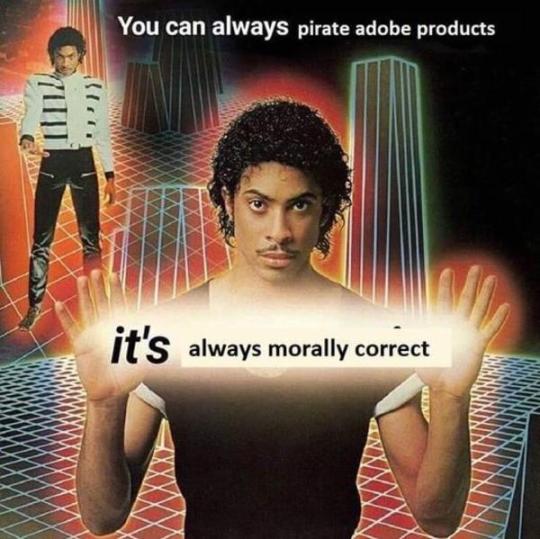
Premiere Pro - Here is where I drag all of my videos down onto the timeline and begin the editing process!
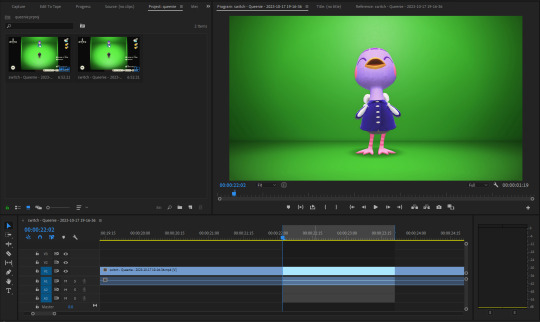
I try to find the best looping points for each reaction. I mark those points using the "Mark In" and "Mark Out" buttons located at the bottom of the preview window. The "Mark In" sets the starting position for the villager reaction and the "Mark Out" sets the ending point, creating a bracket for that specific reaction.
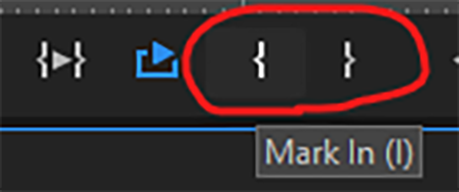
After marking these points, I use the "Play Video In and Out" button and then I make sure to click on the "Loop Playback."
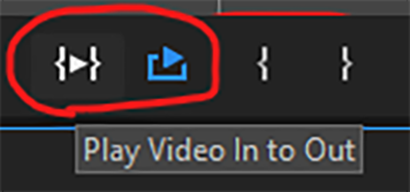
This will not only play the parts of the timeline that I've marked, but it'll loop that exact bracket.

From there, I go to File > Export > Media (or ctrl+m on keyboard). This will bring up the export settings window. I turn the "Source Range" tab to "Sequence In/Out," so it only exports the spots I've marked with the "Mark In" and "Mark Out" buttons.
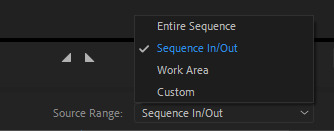
I then go to the source tab at the top and select the cropping tool.
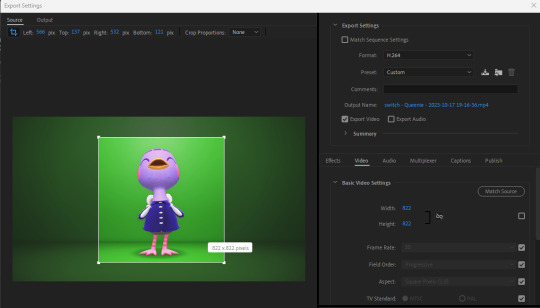
I make sure to click the box under the "Match Source" button to remove the check mark, and then click the chain icon next to height and width settings to put a slash through the symbol. This allows me to freely crop the video and adjust the height and width of the output, so I can make a perfect green screen box around the villager


I then export this video and move on to the next reaction. I have folders for each gif set that I make. They usually look like this for all the villagers I've completed sets for:
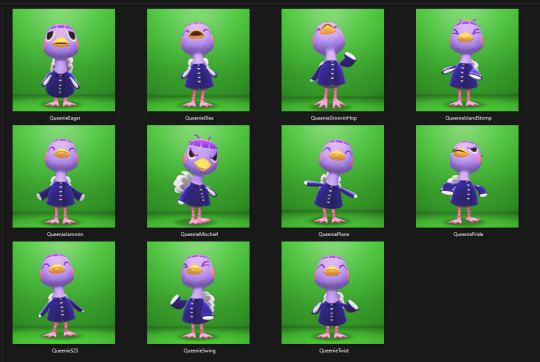
After Effects - Here's where I open all of the reaction files. I go to the effects panel and open the keying tab.
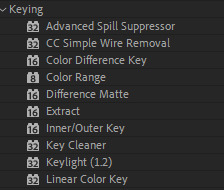
This is where the magic happens! There are three keying effects that I use: Color Range, Key Cleaner, and Inner/Outer Key.
First Effect : Color Range - Starting the keying process, I use dropper tool on any part of the green that's behind the villager. This will only remove some of the background elements because how unevenly colored the green is, due to the lighting of the game.
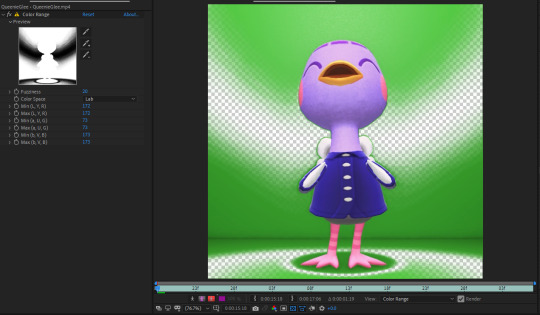
I then use the dropper with a "+" icon on the rest of the background. What helps me is clicking the "Show Channel and Color Management Settings" button at the bottom of the preview window and switching to the "Alpha" view. The alpha channel deals with the transparency of an object and switching to this view allows me to see every bit of the wallpaper and floor that remains. This is where I can apply that dropper+ tool to get rid of them. It doesn't have to be perfect, because the other keying effects that'll be used will help get rid of the loose pixels of green that may still be present.

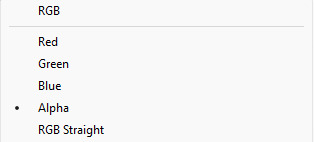
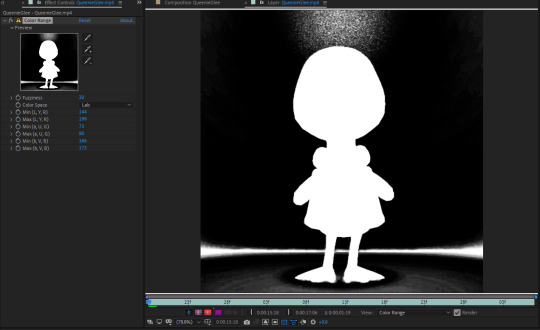
From here, the only adjustment that I sometimes use under this effect is the "Fuzziness" tool. Some villagers will have various color patterns that'll get keyed along with the background. Bringing down the fuzziness helps bring some of those colors back. This does run the risk of bringing some the background pixels back into the video, but that can easily be erased. I usually don't need to adjust the fuzziness. Again, it all largely depends on the colors of the villagers. After all of this is done, I now have a transparent background, but now there's a green outline around the villager:
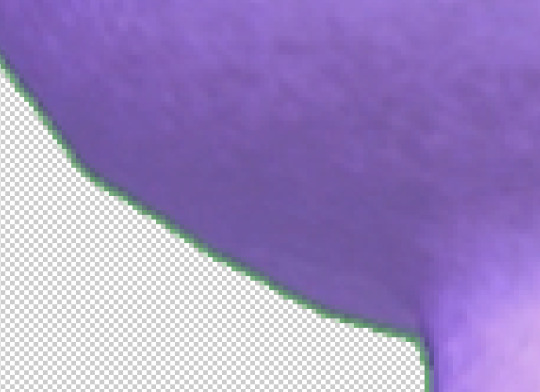
Luckily, the next effect will help with that!
Second Effect: Key Cleaner - This plugin helps clean up the alpha channel around the edges of the villager. The only thing I do here is select the box labeled "Reduce Chatter" and turn the "Alpha Contrast" all the way to 100%.
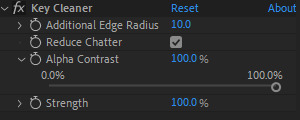
This helps erase most of the outline and makes the edges a little sharper, but there's still a tiny bit of green that surrounds the villager.
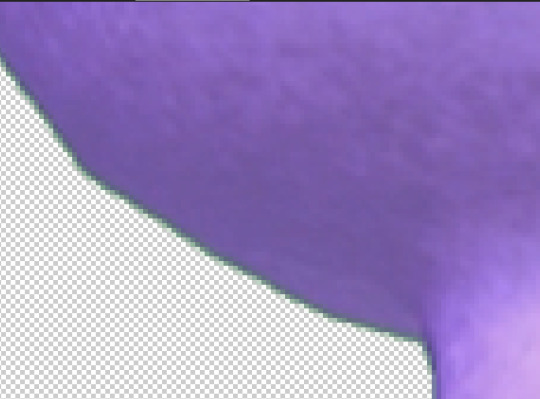
Third Plugin: Inner/Outer Key - I will admit that I don't utilize the entirety of this effect's capabilities. I only adjust the "Edge Thin" and "Edge Threshold" sliders, which should shave off the rest of the green outline.
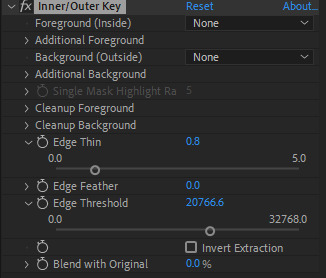
Using these tools, I've now completed the keying process and I have a nice, crisp villager reaction with a completely transparent background!

Next I go to File > Export > Add to Render Queue (or ctrl+m on keyboard). I bring up the output settings by clicking on the "Output Module." I then change the format to QuickTime, which will render the reaction as a ".mov" file. I then change the channel to "RGB + Alpha" to render the object (which is the villager) and the transparent background.
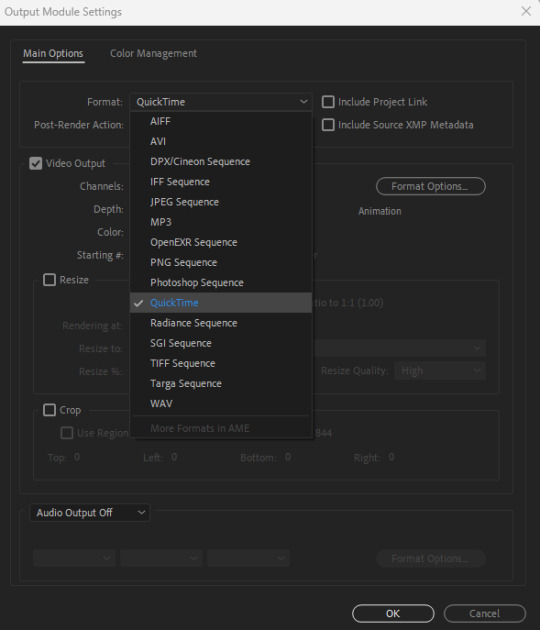

Once this is done, I hit the render button and the reaction has been exported! After doing all of this with the first video file, I highlight all of the effects that I've applied from the effects panel by clicking on the names:
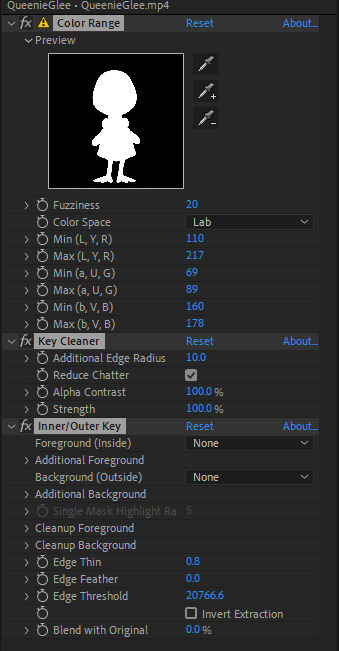
I then hit ctrl+c on my keyboard, open the next reaction into the timeline, and then hit ctrl+v. This copies all the effects applied to the first reaction and pastes them to the next video. I repeat this process for each file so I don't have to redo the entire keying process for all of the reactions. After they're all rendered, I can move onto the final adobe step.
Photoshop - This is where I open all of the QuickTime files that I've exported from After Effects.
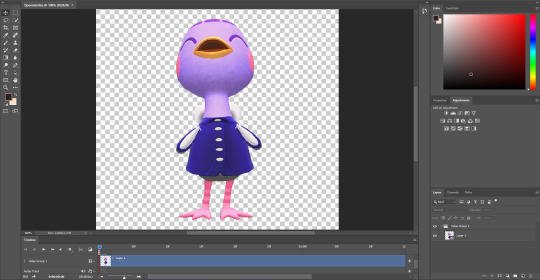
From here, I can apply any adjustments to the villager, whether it be adjusting the brightness, messing around with the hues and saturation, increasing the speed, etc. The main thing I do here is decrease the size. These files are usually huge so I have to adjust the size so I don't risk putting groups of extremely large gifs on peoples' dash. I go to Image > Image Size (or Alt+Ctrl+I on keyboard) and change the width and height to five inches. Of course, any size you choose will work. Five is just perfect for me because it's not too small to ruin the quality of the gif.

After this is done, I got to File > Export > Save for Web (or Alt+Shift+Ctrl+S on keyboard). This is where I can preview the gif.
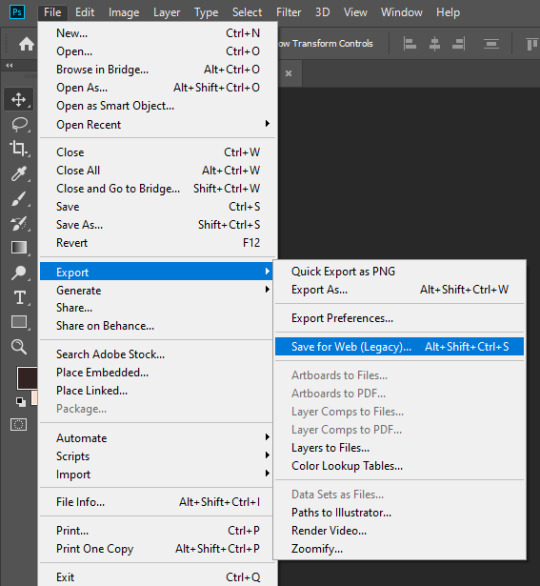
I go to looping options on the bottom right and change it to "Forever," otherwise the gif won't loop. I then turn the matte to "None" so the gif doesn't export with an outline around it. I also make sure that the transparency box is checked. This is what my window looks like before I hit the save button:
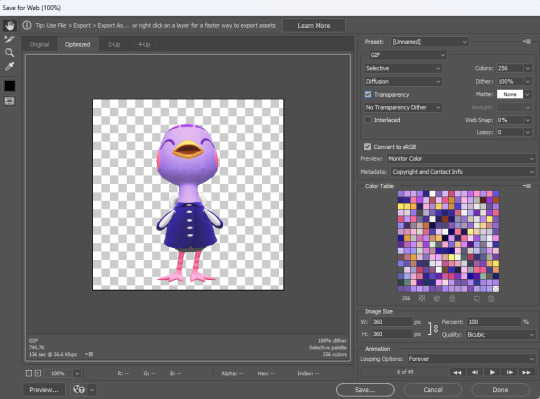
Once I hit save, that's it! Queenie has been exported as a gif. You can see that gif at the top of this post.
If you've made it this far, thank you for reading all of that! I know some parts of this could've been just a simple summary, but I really wanted to show all the details of how I use every application in this gif making process. I will say that I'm no expert at adobe. This is just a method that I pieced together after experimenting with different combinations of keying effects and I managed to make it all work. I apologize if this process seems messy to advanced users out there and I welcome any tips if they help make things easier!
102 notes
·
View notes
